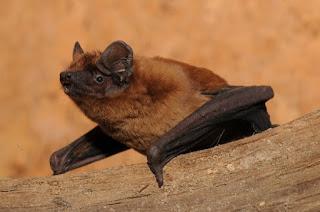
Noctule bat © Jan Svetlik
I'm not a huge fan of bats but they need homes just like the rest of us as new research led by the British Trust for Ornithology (BTO) shows. It highlights how data collected by volunteers taking part in the BTO’s Norfolk Bat Survey can inform planning decisions nationwide.Housing is expected to increase both in Norfolk and throughout the country over the next 10 years or so, resulting in a wave of government planned housing developments. These developments will potentially have an impact on local wildlife due to loss of habitat as new roads and houses are constructed, so it is vital to examine their effects on local wildlife whilst they are still at the planning stage.
The BTO researchers, working with Norfolk County Council used data from the Local Planning Authorities to investigate the impact of the proposed housing on bat distribution and found that different species respond differently.
Planned housing is expected to reduce the activity and distribution of all bat species in Norfolk. At a local level the impact of housing is likely to be severe, with loss for some species as high as 40%. However, at a county level the impact is likely to relate to a maximum 1-2% reduction in bat activity and occupied range, as a result of loss of the bats' preferred habitat.
Importantly, the study showed that the impact of new housing could definitely be reduced; the habitats of least importance for bats could be developed first. Local Authorities could develop areas less likely to impact the bat populations, for example by avoiding forest clearance and instead building more houses in existing city centres
Lead author, Dr Jenni Border of the BTO, said of the research, “The effect of housing depended on the type of habitat that was replaced. For example, new developments around forest habitats would have greater impact than developing in existing urban areas.”
David White, Norfolk County Council, said, “The planned housing in Norfolk is likely to have a negative impact on bats. Nevertheless, this work shows that it is possible for local planning authorities to mitigate against this impact to some extent, by the strategic placement of housing allocations in areas and habitats where the impacts will be less.”
Cadence Ware of the BTO, said, “Research such as this is vital to enable us to fulfill the needs of a rising population without damaging the local wildlife, and the fact that anyone can contribute to these projects through surveys like the Norfolk Bat Survey makes it a really exciting way of engaging people in scientific research, even without any specialist knowledge”
The Norfolk Bat Survey, from which the researchers obtained their data on the activity of the bats, is a pioneering citizen science project which aims to engage the public by allowing people to borrow bat monitoring equipment for a few days and record bat activity in their gardens, giving a unique insight into the activity of bats in a way that could not be gained simply by researchers working alone. Data collected by volunteers were used to create maps showing the distribution of species especially sensitive to urbanization and the resulting loss of those habitats. The project is ongoing for anyone with an interest in discovering more about the wildlife in their garden while aiding valuable research into bat behavior. To sign up and reserve a square to survey, head to http://www.batsurvey.org/norfolk/sign-up/

